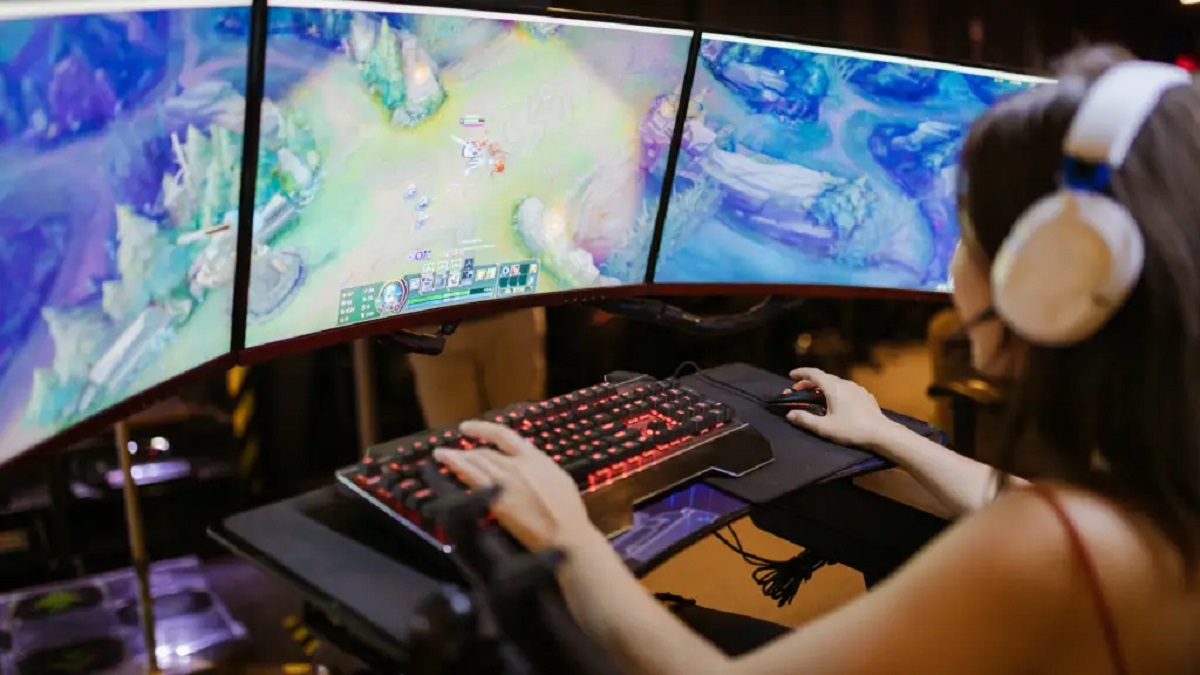Introduction
League of Legends is one of the most popular online multiplayer games, captivating millions of players worldwide. Developed by Riot Games, this competitive team-based strategy game offers intense battles, complex gameplay mechanics, and a thriving esports scene.
To ensure a smooth and enjoyable gaming experience, it is crucial to have a computer that meets the game’s system requirements. One of the factors to consider is the amount of RAM (Random Access Memory) that League of Legends utilizes.
RAM plays a vital role in a computer’s performance, including the speed at which it can process data. League of Legends, like many other modern games, requires a certain amount of RAM to run smoothly and avoid performance issues such as lag or crashes. Understanding how much RAM the game uses and how to optimize its usage can significantly impact gameplay experience.
In this article, we will delve into the topic of how much RAM League of Legends uses and explore various factors that can affect its usage. We will also provide recommendations for optimal RAM configurations and share tips to reduce RAM usage, allowing players to enjoy the game at its best performance.
System Requirements for League of Legends
Before diving into the RAM usage of League of Legends, it’s essential to understand the game’s overall system requirements. These requirements provide a baseline for the hardware needed to run the game smoothly. While RAM is a crucial component, other factors such as the CPU, graphics card, and storage also play a significant role.
According to Riot Games, the minimum system requirements for League of Legends are as follows:
- Operating System: Windows 7, 8, or 10 (or macOS Mavericks 10.9+)
- Processor: 3 GHz processor (supporting SSE2 instruction set or higher)
- RAM: 2 GB or more
- Graphics Card: DirectX 9.0c compatible video card with Shader model 2.0 support
- Storage: 8 GB available space
- Internet Connection: Broadband connection
Note that these are the minimum requirements to run the game, and for optimal performance, it is recommended to have better hardware specifications. The recommended system requirements for League of Legends are:
- Operating System: Windows 10 (or macOS Yosemite 10.10+)
- Processor: 3 GHz dual-core processor or better
- RAM: 4 GB or more
- Graphics Card: NVIDIA GeForce 8800 or AMD Radeon HD 5670 (or equivalent video card with DirectX 10 support)
- Storage: 16 GB available space
- Internet Connection: Broadband connection with a minimum ping of 30-60ms
It is important to ensure that your computer meets the minimum or recommended system requirements for League of Legends. Insufficient hardware specifications can lead to lag, slow loading times, and overall poor performance.
Now that we have an understanding of the system requirements, let’s explore how RAM usage factors into the performance of League of Legends.
Factors Affecting RAM Usage in League of Legends
Several factors can influence the amount of RAM that League of Legends utilizes while running. Understanding these factors can help players optimize their system configurations and ensure smoother gameplay.
1. Map Size and Complexity: League of Legends features multiple maps with varying sizes and levels of detail. The larger and more intricate the map, the more RAM it will require to render and store the necessary data. The game dynamically loads and unloads map assets as players navigate, resulting in fluctuating RAM usage.
2. Game Mode and Number of Players: The game mode and the number of players in a match can impact RAM usage. Modes like Summoner’s Rift, with its complex team fights and strategic gameplay, tend to require more memory compared to simpler modes like ARAM or Twisted Treeline. Additionally, matches with a higher number of players can increase RAM usage as the game processes more actions and information in real-time.
3. Visual Effects and Graphics Settings: League of Legends offers a range of visual effects and graphics settings that can impact RAM usage. Higher-quality graphics settings, such as high-resolution textures, advanced shader effects, and increased particle details, can increase the demand on RAM. Adjusting these settings to a level that suits your system’s capabilities can help optimize RAM usage without sacrificing visual quality.
4. Running Multiple Applications: Running other applications concurrently with League of Legends can also impact RAM usage. Background processes, such as web browsers, streaming software, or voice chat programs, consume additional system resources, including RAM. Closing unnecessary applications can free up RAM and improve game performance.
5. Patch Updates: League of Legends regularly receives patch updates that introduce new content, bug fixes, and performance optimizations. These updates can impact RAM usage as they introduce new assets, modify existing ones, or adjust the game’s code. Keeping the game up to date with the latest patches can help ensure efficient RAM usage.
It’s important to note that the amount of RAM utilized by League of Legends can vary between different systems and configurations. Players with higher-end hardware may experience lower RAM usage, while those with lower-end hardware may notice higher RAM requirements.
In the next section, we will explore the typical range of RAM usage in League of Legends, providing players with a benchmark to assess their system’s performance.
Typical RAM Usage in League of Legends
The amount of RAM that League of Legends utilizes can vary depending on various factors, including the system specifications and in-game activities. While the exact RAM usage may differ from one player to another, we can provide a general overview of the typical range of RAM usage in League of Legends.
Under normal gameplay conditions, with moderate settings and a standard match size, League of Legends typically consumes around 2-3 GB of RAM. This includes the game client, map assets, character models, visual effects, and other game elements.
However, it’s important to note that RAM usage can increase during intense team fights or in matches with larger player counts. During these moments, League of Legends might temporarily utilize more RAM to process the increased number of actions and maintain smooth gameplay.
Additionally, other factors such as background applications and the system’s available resources can also impact the overall RAM usage. Running other memory-intensive programs simultaneously or having limited RAM capacity can potentially lead to higher RAM consumption in League of Legends.
Hardware configurations also play a role in determining RAM usage. Players with higher-end systems, more RAM, and dedicated graphics cards may experience lower overall RAM usage compared to those with lower-end or outdated hardware.
It’s worth mentioning that Riot Games regularly updates and optimizes League of Legends to enhance performance and reduce resource usage. These optimizations aim to improve overall system efficiency and provide players with a more streamlined gaming experience.
By monitoring system performance while playing League of Legends, players can get a better understanding of their specific RAM usage. This can be done through built-in system monitoring tools or third-party software that tracks resource consumption.
In the next section, we will provide recommendations for optimal RAM configurations and share tips to reduce RAM usage in League of Legends.
RAM Recommendations for Optimal Performance
Having the right amount of RAM is crucial for optimal performance in League of Legends. Insufficient RAM may lead to lag, slow loading times, and overall poor gameplay experience. Here are some recommendations regarding RAM configurations to ensure the best performance:
1. Minimum RAM Requirement: As per the system requirements, a minimum of 2 GB RAM is needed to run League of Legends. However, it is highly recommended to have at least 4 GB or more for smoother gameplay. This allows for better multitasking and accommodating background applications.
2. Recommended RAM Capacity: Aim for 8 GB or higher RAM capacity if your budget and system allow. Having more RAM helps with faster data access, reducing the chances of performance hiccups and improving overall stability.
3. Dual-Channel Configuration: Setting up RAM in a dual-channel configuration can further enhance performance. By using two identical RAM modules, the computer can access data in parallel, resulting in improved data transfer rates and overall responsiveness during gameplay.
4. Consider High-Speed RAM: Higher frequency RAM can offer better performance in League of Legends. Aim for DDR4 RAM with speeds of at least 2400MHz or higher to take full advantage of your system’s capabilities.
5. Compatibility and System Limitations: When upgrading RAM, ensure compatibility with your motherboard and existing hardware. Check the maximum RAM capacity supported by your system to avoid any potential compatibility issues.
Investing in ample RAM capacity and higher-speed modules can greatly enhance the gaming experience in League of Legends. It allows for smoother gameplay, faster loading times, and improved responsiveness in high-intensity situations.
It’s important to note that while RAM is a critical component, it should be considered alongside other factors, such as the CPU and graphics card, to ensure a well-balanced system for gaming. Upgrading and optimizing these components collectively can provide the best overall performance.
In the next section, we will provide tips to reduce RAM usage in League of Legends, helping players maximize their system’s capabilities.
Tips to Reduce RAM Usage in League of Legends
Optimizing RAM usage in League of Legends can help improve overall system performance and ensure a smoother gaming experience. Here are some tips to reduce RAM usage while playing the game:
1. Lower Graphics Settings: Adjusting graphics settings to a lower level can significantly reduce RAM usage. Decreasing the level of details, effects, and shadows can free up resources and improve performance without sacrificing gameplay experience.
2. Disable Unnecessary Visual Effects: League of Legends offers various visual effects that enhance the gaming experience. However, disabling non-essential visual effects, such as animations on summoner spells or champion emotes, can reduce RAM usage and improve overall performance.
3. Close Background Applications: Close any unnecessary background applications or processes that consume system resources, including RAM. This includes web browsers, music streaming programs, or resource-intensive chat clients. Freeing up RAM by closing these applications can improve the game’s performance.
4. Limit Startup Programs: Reduce the number of programs that automatically start when you boot up your computer. Having fewer background programs running at startup means more available resources, including RAM, for League of Legends to utilize.
5. Clear Temporary Files: Regularly clean up temporary files and clear cache to free up disk space. This can indirectly help reduce RAM usage by ensuring smooth data retrieval and preventing excessive memory allocation.
6. Close Unnecessary Clients: If you have multiple League of Legends clients or other instances of the game running, close the unused ones. Each client consumes additional resources, including RAM, and closing them can help optimize performance.
7. Update Graphics Drivers: Ensure that your graphics drivers are up to date. Updated drivers often include performance optimizations and bug fixes that can reduce RAM usage and improve the game’s stability.
8. Regularly Update the Game: Keep League of Legends updated with the latest patches and updates released by Riot Games. These updates often include performance improvements and memory optimizations that can enhance RAM usage and overall system efficiency.
Implementing these tips can help reduce RAM usage and optimize performance in League of Legends. Every system and configuration is unique, so feel free to experiment with different settings and options to find the perfect balance between performance and visuals.
Now that you have an understanding of how to reduce RAM usage in League of Legends, you can enjoy a smoother gaming experience even on systems with limited resources.
Conclusion
Optimizing RAM usage is essential for achieving optimal performance in League of Legends. By understanding the factors that affect RAM usage and implementing the right strategies, players can enhance their gaming experience and prevent performance issues.
In this article, we explored the system requirements for League of Legends, highlighting the importance of having a computer that meets or exceeds these specifications. We discussed the various factors that can influence RAM usage, including map size, game mode, graphics settings, and running multiple applications.
Understanding the typical range of RAM usage in League of Legends allows players to gauge their system’s performance and make necessary adjustments. We also provided recommendations for optimal RAM configurations, including minimum requirements, recommended capacity, and dual-channel configurations.
To further enhance performance, we shared tips to reduce RAM usage in League of Legends. These tips include adjusting graphics settings, disabling unnecessary visual effects, closing background applications, and staying up to date with game and graphics driver updates.
Remember, every system is unique, and the specific RAM usage may differ. Monitoring system resources and experimenting with different settings can help find the right balance between performance and visual quality.
By following these guidelines, players can ensure smoother gameplay, faster loading times, and a more enjoyable experience in the world of League of Legends.
So go ahead, equip your computer with sufficient RAM, optimize your settings, and enter the Summoner’s Rift with confidence!

























